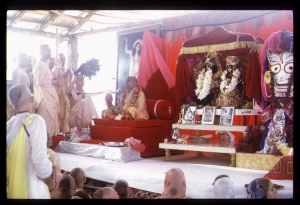CC Adi 1.94: Difference between revisions
m (1 revision(s)) |
(Vanibot #0054 edit - transform synonyms into clickable links, which search similar occurrences) |
||
| (One intermediate revision by one other user not shown) | |||
| Line 1: | Line 1: | ||
{{ | [[Category:Sri Caitanya-caritamrta - Adi-lila Chapter 01|C094]] | ||
<div style="float:left">'''[[Sri Caitanya-caritamrta|Śrī Caitanya-caritāmṛta]] - [[CC Adi|Ādi-līlā]] - [[CC Adi 1|Chapter 1: The Spiritual Masters]]'''</div> | |||
<div style="float:right">[[File:Go-previous.png|link=CC Adi 1.93|Ādi-līlā 1.93]] '''[[CC Adi 1.93|Ādi-līlā 1.93]] - [[CC Adi 1.95|Ādi-līlā 1.95]]''' [[File:Go-next.png|link=CC Adi 1.95|Ādi-līlā 1.95]]</div> | |||
{{CompareVersions|CC|Adi 1.94|CC 1975|CC 1996}} | |||
{{RandomImage}} | |||
==== TEXT 94 ==== | ==== TEXT 94 ==== | ||
<div | <div class="verse"> | ||
kṛṣṇa-bhaktira bādhaka—yata śubhāśubha karma | :kṛṣṇa-bhaktira bādhaka—yata śubhāśubha karma | ||
seha eka jīvera ajñāna-tamo-dharma | :seha eka jīvera ajñāna-tamo-dharma | ||
</div> | </div> | ||
| Line 12: | Line 16: | ||
==== SYNONYMS ==== | ==== SYNONYMS ==== | ||
<div | <div class="synonyms"> | ||
kṛṣṇa- | ''[//vanipedia.org/wiki/Special:VaniSearch?s=kṛṣṇa&tab=syno_o&ds=1 kṛṣṇa]-[//vanipedia.org/wiki/Special:VaniSearch?s=bhaktira&tab=syno_o&ds=1 bhaktira]'' — of devotional service to Kṛṣṇa; ''[//vanipedia.org/wiki/Special:VaniSearch?s=bādhaka&tab=syno_o&ds=1 bādhaka]'' — hindrance; ''[//vanipedia.org/wiki/Special:VaniSearch?s=yata&tab=syno_o&ds=1 yata]'' — all; ''[//vanipedia.org/wiki/Special:VaniSearch?s=śubha&tab=syno_o&ds=1 śubha]-[//vanipedia.org/wiki/Special:VaniSearch?s=aśubha&tab=syno_o&ds=1 aśubha]'' — auspicious or inauspicious; ''[//vanipedia.org/wiki/Special:VaniSearch?s=karma&tab=syno_o&ds=1 karma]'' — activity; ''[//vanipedia.org/wiki/Special:VaniSearch?s=seha&tab=syno_o&ds=1 seha]'' — that; ''[//vanipedia.org/wiki/Special:VaniSearch?s=eka&tab=syno_o&ds=1 eka]'' — one; ''[//vanipedia.org/wiki/Special:VaniSearch?s=jīvera&tab=syno_o&ds=1 jīvera]'' — of the living entity; ''[//vanipedia.org/wiki/Special:VaniSearch?s=ajñāna&tab=syno_o&ds=1 ajñāna]-[//vanipedia.org/wiki/Special:VaniSearch?s=tamaḥ&tab=syno_o&ds=1 tamaḥ]'' — of the darkness of ignorance; ''[//vanipedia.org/wiki/Special:VaniSearch?s=dharma&tab=syno_o&ds=1 dharma]'' — the character. | ||
</div> | </div> | ||
| Line 19: | Line 23: | ||
==== TRANSLATION ==== | ==== TRANSLATION ==== | ||
<div | <div class="translation"> | ||
All kinds of activities, both auspicious and inauspicious, that are detrimental to the discharge of transcendental loving service to Lord Śrī Kṛṣṇa are actions of the darkness of ignorance. | All kinds of activities, both auspicious and inauspicious, that are detrimental to the discharge of transcendental loving service to Lord Śrī Kṛṣṇa are actions of the darkness of ignorance. | ||
</div> | </div> | ||
| Line 26: | Line 30: | ||
==== PURPORT ==== | ==== PURPORT ==== | ||
<div | <div class="purport"> | ||
The poetical comparison of Lord Caitanya and Lord Nityānanda to the sun and moon is very significant. The living entities are spiritual sparks, and their constitutional position is to render devotional service to the Supreme Lord in full Kṛṣṇa consciousness. So-called pious activities and other ritualistic performances, pious or impious, as well as the desire to escape from material existence, are all considered to be coverings of these spiritual sparks. The living entities must get free from these superfluous coverings and fully engage in Kṛṣṇa consciousness. The purpose of the appearance of Lord Caitanya and Lord Nityānanda is to dispel the darkness of the soul. Before Their appearance, all these superfluous activities of the living entities were covering Kṛṣṇa consciousness, but after the appearance of these two brothers, people’s hearts are becoming cleansed, and they are again becoming situated in the real position of Kṛṣṇa consciousness. | The poetical comparison of Lord Caitanya and Lord Nityānanda to the sun and moon is very significant. The living entities are spiritual sparks, and their constitutional position is to render devotional service to the Supreme Lord in full Kṛṣṇa consciousness. So-called pious activities and other ritualistic performances, pious or impious, as well as the desire to escape from material existence, are all considered to be coverings of these spiritual sparks. The living entities must get free from these superfluous coverings and fully engage in Kṛṣṇa consciousness. The purpose of the appearance of Lord Caitanya and Lord Nityānanda is to dispel the darkness of the soul. Before Their appearance, all these superfluous activities of the living entities were covering Kṛṣṇa consciousness, but after the appearance of these two brothers, people’s hearts are becoming cleansed, and they are again becoming situated in the real position of Kṛṣṇa consciousness. | ||
</div> | </div> | ||
__NOTOC__ | |||
<div style="float:right; clear:both;">[[File:Go-previous.png|link=CC Adi 1.93|Ādi-līlā 1.93]] '''[[CC Adi 1.93|Ādi-līlā 1.93]] - [[CC Adi 1.95|Ādi-līlā 1.95]]''' [[File:Go-next.png|link=CC Adi 1.95|Ādi-līlā 1.95]]</div> | |||
__NOTOC__ | |||
__NOEDITSECTION__ | |||
Latest revision as of 18:12, 19 February 2024

A.C. Bhaktivedanta Swami Prabhupada
TEXT 94
- kṛṣṇa-bhaktira bādhaka—yata śubhāśubha karma
- seha eka jīvera ajñāna-tamo-dharma
SYNONYMS
kṛṣṇa-bhaktira — of devotional service to Kṛṣṇa; bādhaka — hindrance; yata — all; śubha-aśubha — auspicious or inauspicious; karma — activity; seha — that; eka — one; jīvera — of the living entity; ajñāna-tamaḥ — of the darkness of ignorance; dharma — the character.
TRANSLATION
All kinds of activities, both auspicious and inauspicious, that are detrimental to the discharge of transcendental loving service to Lord Śrī Kṛṣṇa are actions of the darkness of ignorance.
PURPORT
The poetical comparison of Lord Caitanya and Lord Nityānanda to the sun and moon is very significant. The living entities are spiritual sparks, and their constitutional position is to render devotional service to the Supreme Lord in full Kṛṣṇa consciousness. So-called pious activities and other ritualistic performances, pious or impious, as well as the desire to escape from material existence, are all considered to be coverings of these spiritual sparks. The living entities must get free from these superfluous coverings and fully engage in Kṛṣṇa consciousness. The purpose of the appearance of Lord Caitanya and Lord Nityānanda is to dispel the darkness of the soul. Before Their appearance, all these superfluous activities of the living entities were covering Kṛṣṇa consciousness, but after the appearance of these two brothers, people’s hearts are becoming cleansed, and they are again becoming situated in the real position of Kṛṣṇa consciousness.